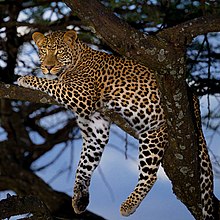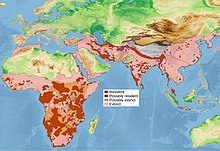
Back Luiperd Afrikaans ግሥላ Amharic Panthera pardus AN Lafor ANG نمر Arabic ܢܡܪܐ ARC فهد ARZ নাহৰফুটুকী বাঘ Assamese Panthera pardus AST Kraimol (Panthera pardus) AVK
| Leopard Temporal range:
| |
|---|---|

| |
| Male African leopard in Maasai Mara National Reserve, Kenya | |
| Scientific classification | |
| Domain: | Eukaryota |
| Kingdom: | Animalia |
| Phylum: | Chordata |
| Class: | Mammalia |
| Order: | Carnivora |
| Suborder: | Feliformia |
| Family: | Felidae |
| Subfamily: | Pantherinae |
| Genus: | Panthera |
| Species: | P. pardus[1]
|
| Binomial name | |
| Panthera pardus[1] | |
| Subspecies | |
|
See text | |

| |
| Present and historical distribution of the leopard[2] | |
The leopard (Panthera pardus) is one of the five extant species in the genus Panthera. It has a pale yellowish to dark golden fur with dark spots grouped in rosettes. Its body is slender and muscular reaching a length of 92–183 cm (36–72 in) with a 66–102 cm (26–40 in) long tail and a shoulder height of 60–70 cm (24–28 in). Males typically weigh 30.9–72 kg (68–159 lb), and females 20.5–43 kg (45–95 lb).
The leopard was first described in 1758, and several subspecies were proposed in the 19th and 20th centuries. Today, eight subspecies are recognised in its wide range in Africa and Asia. It initially evolved in Africa during the Early Pleistocene, before migrating into Eurasia around the Early–Middle Pleistocene transition. Leopards were formerly present across Europe, but became extinct in the region at around the end of the Late Pleistocene-early Holocene.
The leopard is adapted to a variety of habitats ranging from rainforest to steppe, including arid and montane areas. It is an opportunistic predator, hunting mostly ungulates and primates. It relies on its spotted pattern for camouflage as it stalks and ambushes its prey, which it sometimes drags up a tree. It is a solitary animal outside the mating season and when raising cubs. Females usually give birth to a litter of 2–4 cubs once in 15–24 months. Both male and female leopards typically reach sexual maturity at the age 2–2.5 years.
Listed as Vulnerable on the IUCN Red List, leopard populations are currently threatened by habitat loss and fragmentation, and are declining in large parts of the global range. Leopards have had cultural roles in Ancient Greece, West Africa and modern Western culture. Leopard skins are popular in fashion.
- ^ Wozencraft, W. C. (2005). "Species Panthera pardus". In Wilson, D. E.; Reeder, D. M. (eds.). Mammal Species of the World: A Taxonomic and Geographic Reference (3rd ed.). Johns Hopkins University Press. p. 547. ISBN 978-0-8018-8221-0. OCLC 62265494.
- ^ a b c Stein, A.B.; Athreya, V.; Gerngross, P.; Balme, G.; Henschel, P.; Karanth, U.; Miquelle, D.; Rostro-Garcia, S.; Kamler, J. F.; Laguardia, A.; Khorozyan, I. & Ghoddousi, A. (2023). "Panthera pardus". IUCN Red List of Threatened Species. 2023: e.T15954A215195554. doi:10.2305/IUCN.UK.2023-1.RLTS.T15954A215195554.en. Retrieved 16 January 2024.
© MMXXIII Rich X Search. We shall prevail. All rights reserved. Rich X Search
